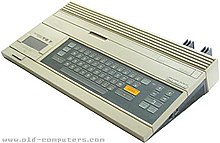


| |
| Developer | Thomson SA |
|---|---|
| Type | Home computer |
| Generation | 8-bit |
| Release date | France: 1 December 1982; 41 years ago (1982-12-01) |
| Lifespan | 1982-1984 |
| Introductory price | 3750 FF |
| Discontinued | May 1984 |
| Units sold | More than 40000 produced |
| Media | Cassette tape, MEMO7 cartridges |
| Operating system | BASIC (in cartridge) |
| CPU | Motorola 6809 @ 1 MHz |
| Memory | 22 KB RAM, 4KB ROM, 16KB cartridges |
| Display | 320 x 200, 8 colours (2 colour constraint for each 8x1 pixels) |
| Graphics | Motorola MCA1300 gate array on TO7/70[1] |
| Successor | Thomson TO8, Thomson TO9 |
The Thomson TO7, also called Thomson 9000[2] is a home computer introduced by Thomson SA in November 1982,[3] with an original retail price of 3750 FF.[4] By 1983 over 40000 units were produced.[4] About 84 games were released for the TO7.[5][6]
The TO7 is built around a 1 MHz Motorola 6809 processor. ROM cartridges, designed as MEMO7, can be introduced through a memory bay. The user interface uses Microsoft BASIC, included in the kit cartridge. The keyboard features a plastic membrane, and further user input is obtained through a lightpen. Cooling is provided by a rear radiator. A standard television can serve as a monitor using a RGB SCART (Peritel) connector, with a resolution of 320x200 (with 2 colors for each 8 x 1 pixels).
The TO7 prototype, called Thomson T9000, was developed in 1980. The differences regarding the production model are a different startup menu and buggier BIOS.[7]
The Thomson TO7 runs on a Motorola 6809 processor clocked at 1 MHz and features 22 KB of RAM (8 KB for the user, 8 KB used as video memory and 8K x 6 bits color memory) and 20KB of ROM (4KB for the monitor and 16KB on MEMO7 cartridges).[8]
As common on home computers designed to be connected to an ordinary TV screen, the 320 x 200 pixels active area doesn't cover the entire screen, and is surrounded by a border.[9] Graphics were limited to 8 colours (generated by combination of RGB primaries) with proximity constraints (2 colors for each 8 x 1 pixel area).[8][3] The video output is RGB on a SCART connector, with the refresh rate being 625-line compatible 50Hz.[8]
Audio featured a single channel sound generator with five octaves. A "game expansion" was capable of four channel, six octaves sound.[2]
The keyboard has 58 keys and includes arrow keys.[2]
Besides cartridges, the machine used cassette tapes for file storage.[2]

An upgraded version, the Thomson TO7/70, was released in 1984[10] with an introductory price of 3590 FF.[11] It was used as an educational tool in French schools under the Computing for All plan, where the TO7/70 could be used as a used a "nano-machine" terminal for the "Nanoréseau" educational network.[10]
Among improvements RAM was increased to 64 KB - "70" on the version name stands for 64+6 (64KB RAM + 6KB ROM).[12] The 6809 processor was replaced by a Motorola 6809E and the color palette was extended from 8 to 16 colors.[13]
Graphics were similar to the Thomson MO5[14] and generated by a Motorola MCA1300 gate array[1] capable of 40×25 text display and a resolution of 320 x 200 pixels with 16 colours (limited by 8 x 1 pixel colour attribute areas).[15][16] The colour palette is 4-bit RGBI, with 8 basic RGB colours and a intensity bit (called P for "Pastel") that controlled saturation ("saturated" or "pastel").[9][17]
Software developed for the TO-7 can be run on the TO-7/70, but the reverse is not possible.[10] At least three games were released for the TO7/70.[18]
|
| ||||||
|---|---|---|---|---|---|---|
| 1st Generation |
| |||||
| 2nd Generation |
| |||||
| PC compatible |
| |||||
| Unix systems |
| |||||
This microcomputer- or microprocessor-related article is a stub. You can help Wikipedia by expanding it. |